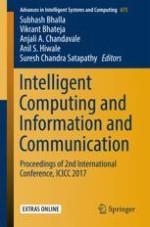2018 | Buch
Intelligent Computing and Information and Communication
Proceedings of 2nd International Conference, ICICC 2017
herausgegeben von: Subhash Bhalla, Prof. Dr. Vikrant Bhateja, Dr. Anjali A. Chandavale, Dr. Anil S. Hiwale, Prof. Dr. Suresh Chandra Satapathy
Verlag: Springer Singapore
Buchreihe : Advances in Intelligent Systems and Computing
